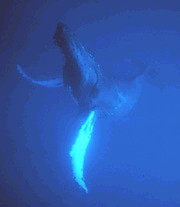|
Scientists for years have suspected a link between sonar activities and mass strandings of marine mammals—similar events have occurred recently in the Bahamas and Greece—but they are uncertain as to why sonar causes the animals to strand themselves.
The new research is based on autopsies performed by scientists with the Institute for Animal Health at the University of Las Palmas de Gran Canaria in Spain shortly after the beaked whales stranded themselves on the beaches of Fuerteventura and Lanzarote.
The researchers cut into and examined eight Cuvier's beaked whales (Ziphius cavirostris), a Blainville's beaked whale (Mesoplodon densirostris), and a Gervais' beaked whale (Mesoplodon europaeus). They found gas bubbles in blood vessels and haemorrhaged vital organs.
"We think the animals arrived at the coast after the beginning of the exercises in an injured state due to a disseminated microvascular hemorrhages in vital organs, associated with a systemic embolism," said Antonio Fernández, one of the Spanish researchers. "After beaching, their situation was worse due to the well-known stress stranding syndrome that did more severity to the lesions, resulting in cardiovascular collapse and death."
Roger Gentry, a scientist with the National Marine Fisheries Service in Silver Spring, Maryland, who studies marine mammal strandings, said the connection between the beaked whale strandings and the military sonar exercises is clear, but he is not certain the sonar causes an ailment similar to decompression sickness, as reported in Nature.
"None of the authors is an expert on decompression sickness and none of the results have been seen by anyone who is an expert on decompression sickness," he said.
The fisheries service is trying to set up a workshop before the end of year where the authors of the Nature paper can present their findings to experts on decompression sickness. Similar research was presented at a workshop organized by the fisheries service in 2002 and it remains a valid hypothesis, said Gentry.
Sonar and Whales
Sonar technology, such as that used during the Cold War, was passive: essentially big microphones that listened for the distinctive sounds emitted by large submarines.
The U.S. Navy and other militaries around the world have since deployed mid-frequency active sonar designed to find a new generation of smaller, stealthy submarines by sending out sound waves and listening for the reflections off objects, thus giving away their location.
The Canary Island strandings occurred four hours after Spanish-led, international military exercises commenced there. Mid-frequency active sonar was deployed as part of training to secure the Strait of Gibraltar, a militarily strategic location.
Environmentalists say incidences of marine mammal strandings have sharply increased since this mid-frequency sonar technology was deployed. Environmentalists are now actively opposing testing of a new technology, called low-frequency sonar, which they say would significantly expand the geographic range the sound travels.
Joel Reynolds, a senior attorney and director of the marine mammals program for the Natural Resources Defense Council in Los Angeles, California, says the new research in Nature "is another reason why it is important to regulate the proliferation of active sonar systems around the world."
This August a U.S. District Court judge in California ordered the U.S. Navy to negotiate with environmental groups on when, where, and how it tests the low-frequency sonar.
Gentry with the National Marine Fisheries Service said that the low-frequency sonar is quite different than mid-frequency—operating at 100 to 300 hertz instead of 2,000 to 10,000 hertz—and there is no evidence that low-frequency sonar has caused any strandings.
"The problem we know about is mid-frequency," he said. "There is no firm basis for extrapolating from one group to another."
Mitigating Impacts
Paul Jepson, a wildlife epidemiologist at the Zoological Society of London, who is the lead author of the Nature study, said the findings highlight a need for naval and marine mammal scientists to collaborate in order to advance the understanding and mitigation of the impact of active-sonar equipment on cetaceans, particularly beaked whales.
"In order to mitigate the impact of sonar on cetaceans, we need to know where these species are and when they are there," said Jepson.
Gentry said that the fisheries service and the U.S. Navy recognize that there is a cause and effect relationship between the mid-frequency sonar and beaked whale strandings and the agencies are changing the way they use mid-frequency sonar to mitigate the impacts on beaked whales.
"In general, we are very well aware of these strandings and the association with military sonar," he said. "We know we have to be cautious in setting guidelines."
While the fisheries service is not clear why the sonar causes the whales to strand themselves, Jepson and colleagues write in Nature that the sonar likely either causes a behavioural change in the whales such as rising too rapidly, or there is a physical effect of the sonar on bubble precursors in nitrogen-saturated tissues.
This physical effect of sonar on whales was proposed by Dorian Houser of the Navy Marine Mammal Program and colleagues in San Diego, California, in 2001.
Houser and colleagues devised a mathematical model that shows low-frequency sound waves can rapidly compress and then expand microscopic bubbles of gas in the tissue. Each sound wave causes the bubble to absorb more and more of the gas dissolved in the bloodstream, eventually making the bubbles big enough to rupture tissues.
Top
|
